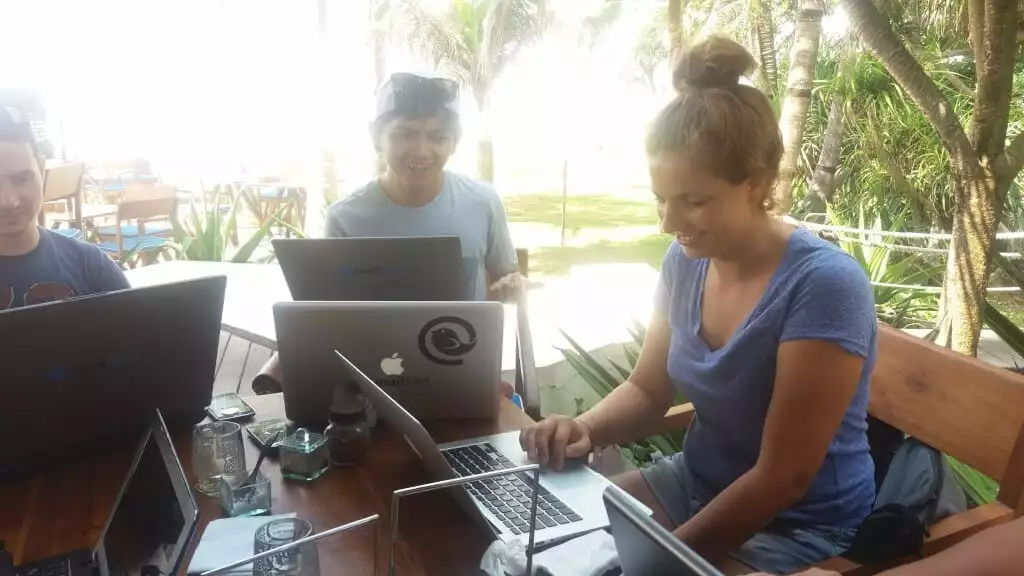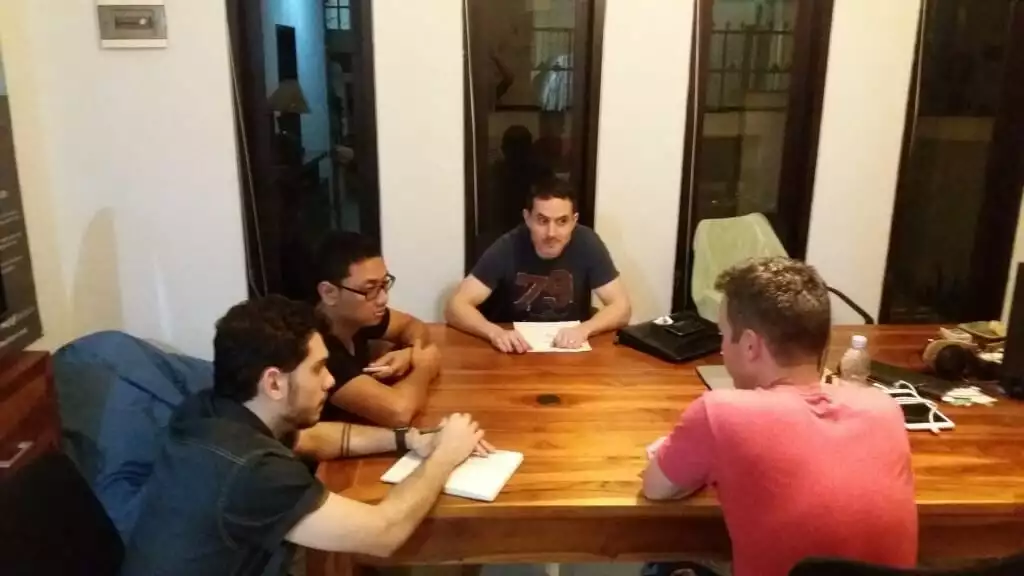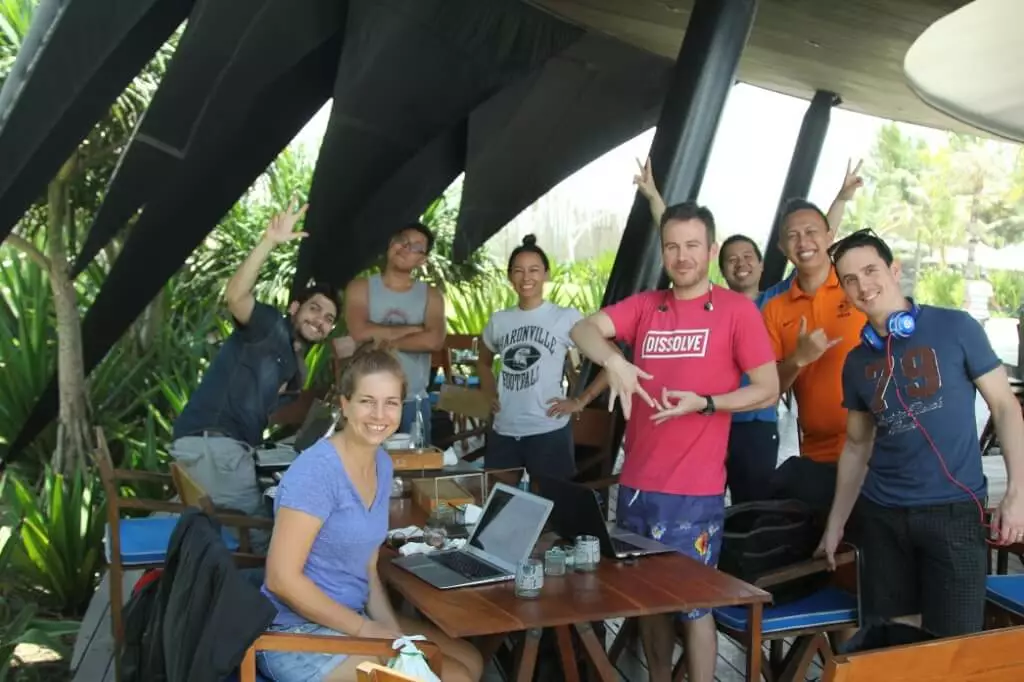Creating & Maintaining a Relaxed Culture for Remote Teams
Leading distributed teams presents unique challenges, particularly in building strong team relationships without face-to-face interaction. This guide explores proven strategies for creating essential "water cooler culture" among remote employees, covering effective onboarding practices and team-building methodologies that boost productivity and retention in distributed work environments.

Article Updates
- August 2025: Updated to refresh content with current information.
There are, however, significant challenges that may arise with leading distributed teams. Since you are not interacting face-to-face with the team on a daily basis, it can be easy to just focus on deliverables and overlook the crucial aspect of team-building. According to Gallup's workplace research, remote employees who feel disconnected from their team are 21% less productive than those with strong team relationships. Creating a relaxed, water cooler culture with your remote employees is essential to your success. In one of our previous posts, we gave you " 10 Quick Tips on Leading A Remote Team".
Now let's look at what you can do to create that water cooler culture among all of your remote team members, backed by industry best practices and proven methodologies.
On-Boarding New Employees
In order to ensure every employee is on the same page, you must provide everyone with a similar starting point. When a new employee is brought on board in an office, HR leads her around, introducing her to her coworkers. She is often taken to lunch by her boss, where they chat, and get to know one another. Her boss is then able to take her personality, and assist her in forging relationships that suit all parties well.
Since remote teams do not have the aforementioned in-person luxuries, it is imperative to have all current employees reach out personally, to introduce themselves to new hires. Research from the Society for Human Resource Management shows that effective onboarding can improve employee retention by 82% and productivity by over 70%. This not only provides a more welcome feeling, it fosters a sense of "fitting in" which is particularly important if your remote employees come from different countries and cultures — for example, you might predominantly hire in the US but also have employees based in Asia, Europe, or other locations. As Harvard Business Review research indicates, people still have a fundamental need to fit in with a group socially, even in virtual work settings. Do not simply tell your new employee, "hey, this is the team, reach out with any questions." Encourage your current team to make her feel welcome. At her first meeting, have her give a quick recap of who she is as a person outside of work. Whatever her interests are provide a great way for coworkers to spark up a conversation.
At Mailbird, we have a month of on-boarding to make the new team mate feel as welcomed as possible. Usually our CEO has a meeting with her/him every day of the first week to introduce them to the tools, our company culture and set up. The second week will be used for small introduction meetings with every team member (depending on the size of your company this might not be possible). And the last 2 weeks of the month will be an intense on-boarding to all their tasks, sprint, roadmap and backlog within the team.

Get to Know Each Other
Getting to know one another goes hand-in-hand with the previous tip and is supported by extensive workplace psychology research. From the beginning, you should always provide ways for employees to connect with each other. McKinsey's organizational research demonstrates that when employees have more of a working-friendship, it is easier to reach out with questions or when they are in need of guidance. Nervousness does not arise, and productivity increases by up to 25% when people feel like they can interact freely.
Prior to getting down to business before a meeting, ask everyone a question about their personal preferences. What is your favorite fast food restaurant? If you could take a vacation today, where would it be? What is your dream car? What is your favorite sport? These types of questions loosen up the mood, and provide topics of conversation for later. According to workplace psychology research, these informal connections create the foundation for stronger professional relationships. Phil may reach out to Hassan about their mutual love for restoring old Mustangs. You never know what may spark an interaction!

Keep a running list of all employees' skills and post it in an easily navigable place. Encourage people to reach out to those with a background in a subject where they need help. Deloitte's workforce research shows that organizations with strong internal knowledge sharing are 35% more likely to outperform their competitors. Not only will this mitigate confusion as to who can do what, it saves time because nobody even has to ask who the expert is in the first place!
Encourage the Use of Non-Work-Related Apps
Communications between employees needs to go outside of the typical messaging programs, such as Skype and Jabber. If you really want to foster a relaxed culture for distributed teams, it is important to set up collaboration channels, such as Slack and Zoom. Microsoft's workplace collaboration research shows that these applications essentially act as a virtual water cooler, by allowing employees to chat about anything, instead of just work-related topics. Plus, it records all of your conversations, and you can go back and reference them.
Setting weekly or bi-weekly themes on these chat applications is a super fun way for people to interact. Around Halloween, encourage people to post pictures of a time they dressed up in a costume. Perhaps you are running a company-wide animal appreciation week. Ask everyone to post a pic or story about their pet. Gallup's employee engagement studies show that your employees will love sharing small pieces of their lives, and seeing a bit more into those of their coworkers. These themed events can also be incorporated into your HR calendar to ensure regular engagement and team-building activities throughout the year.
By no means do these conversations need to be strictly text-based. In fact, you would be remiss not to share your favorite GIF keyboard with everyone. There is always a GIF for any situation, so why not get into an occasional GIF war? Share funny YouTube videos, amusing Imgur pics, or a ridiculous post you found on Reddit. Psychology research confirms that humor is a great way to connect with people and build stronger professional relationships.
Music is another phenomenal way for your employees to connect. An easy, awesome benefit would be to offer a company-wide paid music subscription service, such as Pandora or Spotify. Many remote employees already listen to music throughout the day. Industry research on workplace music benefits shows that by providing this perk, your employees will feel like you care about their work-life quality. Moreover, a shared service allows people to view what others are listening to. Music is universal, and an easy way to get to know one another.
Humor plays a very big roll in Mailbird. Not only during our Hackathons, when most of the team meets up and works side by side together. Also, when we are spread out over 5 continents we send each other fun messages and memes to make each other smile and motivated for the next day and week.

Coordinate How You Work
While creating this relaxed water culture, you must remember to focus on the reason you hired employees: to work. In order to have a basis for that relaxed feeling, it is necessary to make sure everyone is on the same page. As mentioned with on-boarding employees, provide guidelines for everyone.
Would you prefer to give customers a quick response or quality one? What is the best way to communicate in a deadline situation? What timezone are you using? How many hours should an employee realistically put in each week? When it comes to synchronous vs. asynchronous work, what do you prefer? Atlassian's remote work research emphasizes that while these are simple questions, they can be very easy to overlook. Consider other easily-missed details you expect your employees to know, and compile a list. Bring this list to your next meeting, allowing questions to ensure everyone understands.
When you see someone beginning to deviate greatly from these general guidelines, have a conversation with him or her. Harvard Business Review's management research shows that by maintaining an open line of communication and providing clear company guidelines, it will reduce the amount of stress surrounding this type of conversation. You have built a company on trust, responsibility, and respect, and it is reflected in these interactions.
We use different apps in Mailbird to maintain good communication and productivity and with that great work ethics. We have listed a great choice (in our opinion) of apps in our post " The Challenges Of Remote Working: "Maintaining Productivity With A Distributed Team".

Meet In-Person
You can only get so much done as a remote team. In-person meetings clearly are not necessary all the time, but they are a phenomenal tool to boost creativity and team-building. McKinsey's organizational research recommends setting up a retreat at least once-a-year so your distributed teams can interact face-to-face. Try to find a central location that works for everyone - here's a good guide to Europe to help with that. This absolutely encourages your employees to really get to know one another-instead of with a screen between them.
These marathon sessions, or Hackathons, are a springboard for tons of brainstorming and ideas to improve the company as a whole. Forrester's workplace research indicates that in addition to finding improvements for the team and communications, it provides a great way to refresh everyone on the company guidelines. This allows everyone to reset their expectations and interactions, in terms of their role as remote employees.
Mailbird is running a Hackthon at least once a year. During that time we get to work side by side and get some things done faster than we would have via chat apps or email. Our Hackathons are a great mix of day trips for team building, "Learnathons" to understand the tasks and responsibilities of each "department" better and of course to get s#$%* done. We would recommend any distributed team to host these kind of get together on an annual basis to keep the team spirit and team bonding at its peak.

Make Things Happen
It may seem obvious, but once your expectations are set, things need to happen. Your team needs to be productive. To have a successful company, your team must be able to coordinate and work as cohesive unit to meet deadlines. Gartner's workplace productivity research shows that without this type of dynamic, you will run into constant road blocks. This is certainly an all encompassing tip, and it is the most important, by far.
If you're running a remote team or serious about starting one, this is the conference for you. The Running Remote Conference 2018 is carefully curated to teach you next-level, actionable strategies and tactics you can utilize the very next day to manage & grow your remote team. This is the conference that has never existed before and it's more important than ever for the future of work. Learn from leaders of companies like Buffer, Atlassian, Doist, FlexJobs, Transferwise, Dribbble, GitHub, GitLab, Time Doctor and of course, Mailbird. It's right around the corner, on June 23 and 24 in 2018 this year. Early bird prices available at: https://runningremote.com

You have built your team with trust and communication. At some point, you may have to constantly check in on someone to hit a deadline. Deloitte's leadership research confirms that it can be tough, but in order to satisfy customers and grow business, sometimes you have to push harder than you usually do. Since you have such great rapport with your remote teams, it makes it far easier to have these tough, sometimes pushy conversations.
Building a relaxed, water cooler culture with remote teams ultimately comes down to communication. Disseminate information in a timely, agreed-upon manner. Encourage banter or silly back-and-forth between coworkers. Gallup's management research shows that the environment of any distributed teams relies on its leader focusing on fostering this sense of relaxation. You are the driver behind the water cooler culture. Start with the on-boarding of new employees, and see your company flourish!
Mailbird. Unify all of your online communications in one place for your remote team.
FAQs
What are the biggest challenges in creating a relaxed culture for remote teams?
The primary challenges include the absence of spontaneous face-to-face interactions that naturally build relationships, difficulty in reading non-verbal cues during virtual communications, and the tendency for team members to focus solely on task completion without engaging in relationship-building activities. According to research by Buffer's State of Remote Work report, 21% of remote workers struggle with loneliness, which directly impacts team culture. Additionally, time zone differences can fragment team interactions, making it harder to establish consistent cultural touchpoints that foster a relaxed, collaborative environment.
How can managers replicate "water cooler conversations" in a remote work environment?
Successful remote teams implement structured informal interactions through dedicated Slack channels for non-work discussions, virtual coffee breaks scheduled weekly, and "random pairing" systems that connect different team members for 15-minute casual conversations. Industry leaders like GitLab and Zapier have demonstrated that creating specific time slots for informal interaction—such as the first 5 minutes of meetings for personal check-ins—can effectively simulate organic office conversations. Additionally, implementing virtual co-working sessions where team members work silently together on video calls helps recreate the ambient social presence of a physical office environment.
What specific tools and technologies work best for maintaining team culture remotely?
The most effective technology stack combines communication platforms (Slack or Microsoft Teams for instant messaging), video conferencing tools with breakout room capabilities (Zoom or Google Meet), and culture-specific applications like Donut for random team pairings or Bonusly for peer recognition. Research from MIT Sloan shows that teams using multiple communication channels report 25% higher satisfaction with team culture. Essential features include persistent chat rooms for ongoing conversations, screen sharing for collaborative work sessions, and integration capabilities that allow seamless workflow between tools. The key is selecting tools that reduce friction in communication rather than adding complexity to daily interactions.
How do you measure the success of a relaxed remote team culture?
Effective measurement combines quantitative metrics with qualitative feedback. Key performance indicators include employee Net Promoter Score (eNPS), participation rates in voluntary team activities, response times to non-urgent communications, and retention rates compared to industry benchmarks. Quarterly pulse surveys should assess psychological safety, team cohesion, and work-life balance satisfaction. Leading remote-first companies like Automattic track "culture metrics" such as cross-departmental collaboration frequency and the ratio of work-related to social interactions in team channels. Additionally, monitoring voluntary overtime patterns can indicate whether the culture supports healthy boundaries or creates pressure for constant availability.
What are the most common mistakes managers make when trying to build remote team culture?
The most frequent errors include over-scheduling mandatory "fun" activities that feel forced rather than organic, failing to account for different personality types and cultural backgrounds in team-building approaches, and neglecting to establish clear boundaries between work and social interactions. Harvard Business Review research indicates that 43% of remote culture initiatives fail due to lack of authentic leadership participation—managers who don't genuinely engage in cultural activities signal that they're not truly important. Other critical mistakes include ignoring time zone equity (scheduling activities that consistently exclude certain team members), focusing only on group activities without supporting one-on-one relationships, and implementing culture changes without gathering team input on preferences and communication styles.